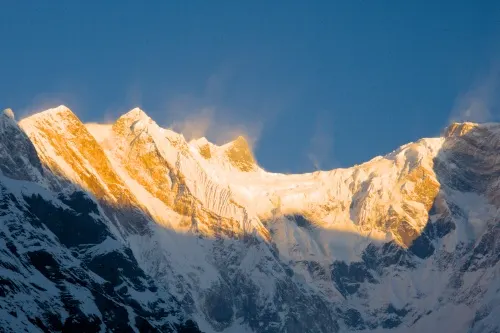
(Golden sun rays in the morning- at Annapurna Base Camp)
We just returned from our trekking to Annapurna Base Camp today. The mountain scenery, the challenge to our physical and mental strength, and our encounters during the hike all culminated in an unforgettable experience.
This article compiles a list of frequently asked questions about trekking to Annapurna Base Camp. Our list is based on our personal experience over the past ten days, and we hope it can serve as a valuable source of information for those planning their hiking adventures.
1. Internet connection
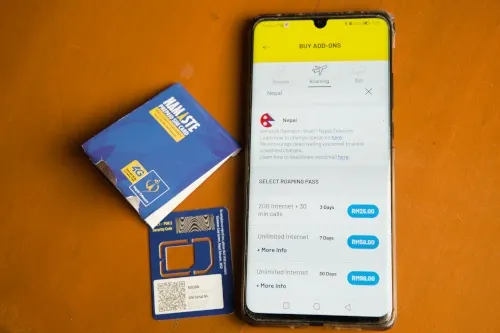
There are a few ways to connect to the internet in Nepal. One option is to buy a roaming pass from your home country. This option is the easiest, but it has its upsides and downsides. Different mobile service providers may have different policies. For example, I am from Malaysia and purchased a 30-day pass to connect my Digi from Malaysia with various Nepal mobile service providers, including NCell and NTC. It costs RM98 (about USD 20), with daily usage capped at 2GB.
Another option is to opt for a local SIM card. Our guide recommended the NTC card as it is more reliable in the ABC area. With this, you can purchase a prepaid card that offers 20GB for 1000 Rs. However, the process is more complex than activating roaming from the home country. My teammates must provide their passports and personal information to the mobile phone dealer to complete the required details. Other information includes their father's, mother's, and grandfather's names. They must also upload a selfie as part of the application's requirements.
The internet signal during the entire ABC Trek can be unpredictable. Sometimes, we get signals at the hotel, and sometimes we don't. Occasionally, we suddenly get a signal when we're far away from the village. We usually get one to two bars, but getting full bars is rare.
There is no internet signal at ABC's accommodations. However, we paid Rs 300 to get Wi-Fi from the hotel. I assume it works using satellites. The pass is valid for two days.
Watch the video :Twelve things to know before trekking to Annapurna Base Camp (At the end of this article) 👇👇.
2. Visa application

We want to highlight the visa application so you will avoid getting into trouble. We asked our ticketing agent to apply for the visa, which cost us RM240 for a 30-day visa. Alternatively, you can apply for a visa at the Nepal Embassy in Malaysia.
Another option is to get the visa on arrival when you clear the immigration at Kathmandu Airport. My friend did that and was charged USD50 to process the visa on the spot.
However, please be aware that some websites offer the service to apply for the Nepal Visa, which can be dubious. We know of an incident where the website issued the visa, and my friend downloaded the visa successfully. However, upon arriving at the Kathmandu airport, the computer system did not have the information of such an application. He then had no choice but to pay for the visa on arrival again. I am unsure whether it is a scam, but after knowing about this incident, I would not encourage you to apply online.
The visa costs RM140 for 15 days and RM240 for 30 days. Our ticketing agency charges a handling fee for the service.
3. Hotel facilities
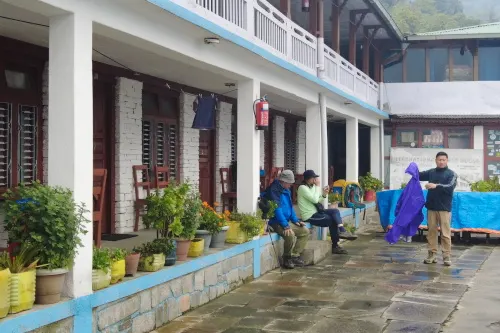
While trekking to Annapurna Base Camp, most of the accommodations are called hotels and restaurants, they are operated mainly by the locals who run them as homestays. As such, they are not operated by hotel chains. Some hikers also referred to these places as tea houses or lodges.
Those tea houses at the beginning of the trek will have attached toilets, but those hotels at higher altitudes (from Tadapani upwards) only have shared toilets and bathrooms. When the altitude gets higher, the facilities will become more basic. Most rooms will start only to have beds and without tables and mirrors. The shared toilets and bathrooms are also becoming more basic, and toilet paper and wet tissue are not allowed to be flushed into the toilet bowl. They will provide a wastebasket to put the used papers.
The tea houses at ABC and Deurali are the most basic. Four of us stayed in a room with only sufficient space to arrange four beds tightly. The room has only one light, without hangers and a mirror. The electricity at ABC is supplied by solar energy, so it is pitch dark at night. We needed to switch on our headlamps when using the toilet outside the room. (There was also no electricity in the toilet.)
4. Food served at the restaurants
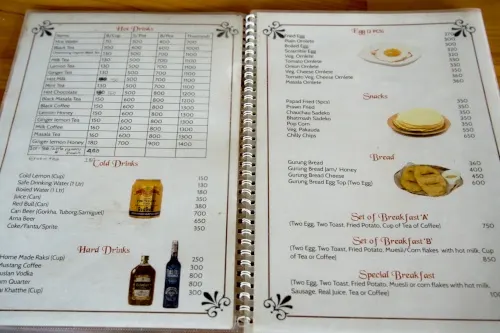
There is an abundance of food options available throughout the trek. Most of the restaurants along the way all serve nearly identical food. However, since these establishments are primarily homestays owned by local villagers who may not be professional cooks, please do not expect to always get excellent food while trekking to Annapurna Base Camp. For example, we ordered Thukpa a few times, which was presented differently each time. One restaurant used short, flat noodles, while another used longer noodles. Similarly, one of our teammates ordered half-boiled eggs, which turned out to be completely hard-boiled.
Below are some sample menus from a few restaurants. It seems they do accept orders that are not on the menu. For instance, one restaurant did not have Thukpa (soup noodles) on its menu, but we requested it, and they were happy to prepare it for us.
The portions are generally moderate, but if you're a big eater, we recommend ordering Dal Bhat, as it comes with unlimited rice refills. Sometimes, you can request more vegetables and dal. It's the best option if you're looking for a filling meal.
As we climb higher altitudes, the cost of food increases due to the difficulty of manually bringing ingredients up. Moreover, meat is not served at higher elevations. During our journey, we have not encountered any restaurants serving meat at Deurali, MBC, or ABC.
The Annapurna Sanctuary in Nepal is a sacred place where slaughter is strictly prohibited. Therefore, only vegetarian food is available in the higher regions of the Annapurna Base Camp Trek.
Most restaurants will close after dinner, so they will not provide food afterward. The dining hall will be converted into a place for the porters to stay. Therefore, no food is served beyond dinner.
5. Drinking water
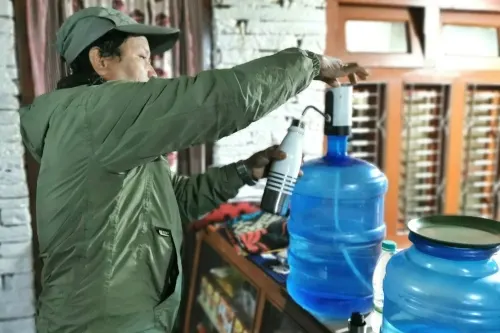
We brought a 500ml thermal flask and a water tumbler during our trip. The thermal flask was very useful because the water in the tumbler became too cold to drink at high altitudes. We found no need to carry more than a liter of water while trekking to Annapurna Base Camp because many restaurants along the way sold water. However, we noticed a trek between MBC and ABC where we couldn't find any restaurants that sold water.
Bottled water was available at lower altitudes, but as we progressed higher, it was no longer available. Instead, we could purchase filtered water. The cost of water also increased gradually as we went higher. For example, we bought one liter of bottled water for Rs 50 at Ghorepani. When we reached ABC, filtered water was sold at Rs100 for 500ml, and boiling water was Rs150 for 500ml.
6. Electricity and charging facility
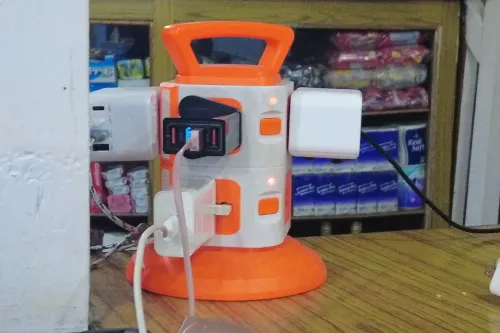
The electricity at various places we stayed was interrupted numerous times, ranging from a few minutes to a few hours. It happened when we were at Tadapani and Ghorepani.
Besides, half of the hotels we stayed in did not have charging facilities in the room. Some of them have an electric socket in the room, but mostly, it does not work. In this case, we will go to the dining hall, where they will have charging facilities. However, there can be many people wanting to charge their devices simultaneously, so we charge our devices during non-peak hours.
There is no charging facility at ABC hotels, so we must fully charge our phones and cameras before trekking to Annapurna Base Camp from MBC. We use a 65-watt power bank that provides enough electric power to keep our cameras and phones running during our hikes.
7. Currency
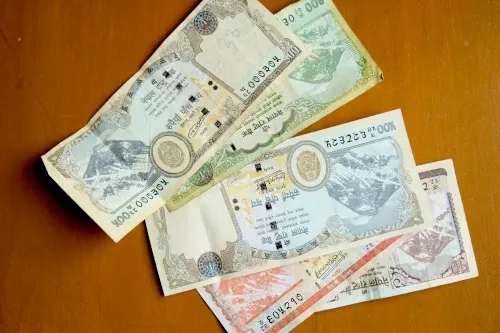
The currency used throughout our trip is the Rupee. We have never used USD or other currencies for transactions.
There are many money changers in Kathmandu and Pokhara, so you can easily change the local currency. However, we will be charged when we withdraw Rupee from an ATM. We withdrew Rs 10000 using a WISE card and were charged Rs 625 for the transaction. We don't know if this applies to other credit or debit cards.
Lastly, a 13% VAT is applied to all restaurant transactions when paying by debit card.
8. Last-minute purchase at Pokhara or Kathmandu
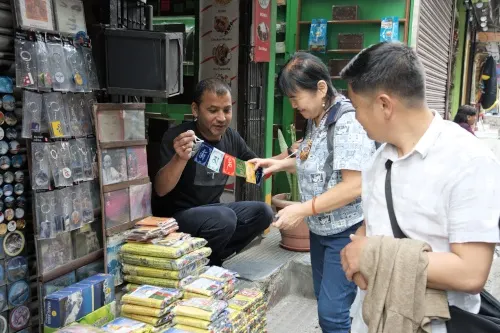
You can purchase anything related to trekking to Annapurna Base Camp at Kathmandu and Pokhara. After arriving, we exchanged our currency at a local money changer and went shopping. As we already had everything we needed for hiking, we didn't purchase anything.
9. Insects
Tiny spiders, bees, and insects sometimes visit the hotel, but they don't bother us. We didn't need insect repellent while hiking because there were no leeches or mosquitoes.
10. Food to bring for hiking
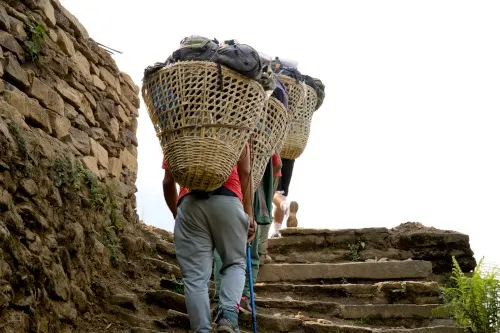
We brought no special food except oral rehydration salt to replenish the salt lost during hiking. You can bring energy bars and chocolates if you want, but it is not mandatory. The porters did not need all these, but they were all big eaters, taking Dal Bhatt with a large portion of rice. We ate a lot and felt fine without using specific food to boost our energy levels.
11. Is it challenging to trek to ABC?
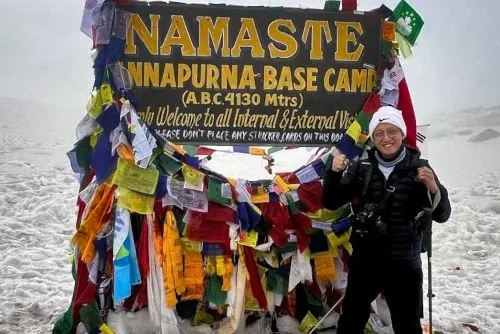
This is a difficult question to answer. The locals and porters can carry several times the weight of our backpacks and still walk much faster than us. However, this is not the case for most hikers. We prepared by hiking regularly, climbing stairs with a backpack, and regular weight-bearing exercises to strengthen our muscles. These activities helped us complete the ABC trek without much trouble, although it was still a strenuous and challenging experience.
During the trek, we walked through various terrains, including places with flights of high-stepped stone slabs, rocky paths, muddy trails, and beautiful forests. We also passed through slippery avalanche areas (with crampons), walked on snow, and crossed suspension bridges. The ABC Trek allowed us to experience it all!
On average, we covered a distance of around 10 km daily, which took us approximately six hours. This is our pace as we are all above sixty years old. You are likely to require less time if you are younger and stronger.
We began our hike from Hille (1500m) and reached ABC (4130m), covering a total distance of about 85 km. The return trip is slightly shorter.
12. How long does it take to complete the ABC Trek?
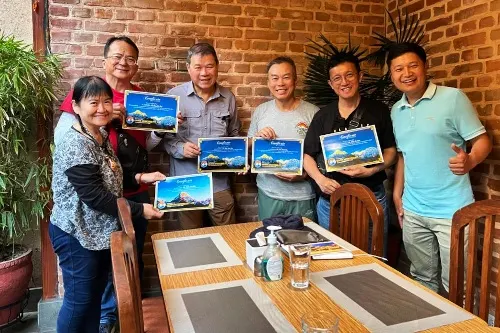
(Received our certificate of achievement from Grande Adventure)
We completed a ten-day trek starting from Hile to Ghorepani, then hiked up to Poon Hill before trekking to Chomrong. From Chomrong, we made our way up to ABC and then returned to Chomrong before descending to Jhinu to take a jeep back to Pokhara.
Alternatively, a shorter route is available where one can start from Jhinu to ABC and back to Jhinu, which reduces the trek by four to five days because it does not include the ascent to Poon Hill. The number of days required for the trek also depends on the trekker's speed, as some experienced hikers can complete the journey from Chomrong to ABC in just two days instead of the usual three.
Bonus tips: What are the most important items to bring while trekking to Annapurna Base Camp

Out of a long list of things in our packing list, below are the most essential items we need throughout our hiking.
- We needed thick clothes to wear at ABC. It was minus four degrees Celsius at night, so keeping us warm without a heater was essential.
- We used sleeping bags because the temperature was too cold, even though the tea house provided blankets. Grande Adventure, our tour company, provided sleeping bags, so we did not need to bring them from home.
- Grande Adventure also provided duffle bags. These tough and sturdy bags are suitable for porters to carry.
- The thermal layer is essential because of the cold temperature. We wore them for the whole day.
- We applied lip gloss to prevent lip cracking due to the cold temperature.
- Similarly, cream and lotion are essential for the same reason.
- My wife used two hiking poles. It depends on your requirements. I use one because it is more convenient to free the other hand to take photos and make videos.
- Wet tissues with no perfume are for situations when you do not want to take a bath. When there was no electricity, hot water was also unavailable at Ghorepani. It was too cold to bathe, so we abandoned the idea of bathing. Tea houses provide hot water for a fee, but I decided to skip that. Use wet tissues to clean instead of taking a bath. Wet tissues are also helpful in cleaning the sitting toilet before use since many hotels do not have attached bathrooms. Be prepared to use the shared bathroom.
- Toilet paper is essential. All the hotels we stayed in did not provide toilet paper.
- Headlamp is essential for two reasons. First, it is required for the hike up to Poon Hill since it starts before dawn. Secondly, it is helpful to go to the toilet in the middle of the night when there is no electricity, which happened when we were at ABC,
- Extra socks and hiking shoes saved us from wearing wet socks and shoes the next day after we accidentally stepped into foot-deep ice while hiking up to ABC from MBC.
- Grande Adventure provided us with crampons, which must be used during hiking down from ABC to MBC, as the snow had turned into ice overnight. We also used it while crossing the avalanche area.
- It was too cold to drink ice-cold water, so a thermal flask was the savior when we needed water at night.
The above summarizes the essential items you should bring during your Annapurna Base Camp Trek, based on our trekking experience just completed two days ago. In the coming weeks, we will upload more information about trekking at ABC Trek, including various aspects such as the scenery and the complete itinerary. In the meantime, we hope this summary provides you with the most reliable information before embarking on your dream adventure.
VJ Tamang, owner and tour guide of Grande Adventure, expertly organized and made our trip enjoyable. VJ can be contacted at https://www.grandeadventure.com/contact-us/ or through https://web.facebook.com/GrandeAdventures.
Watch the video : Twelve things to know before trekking to Annapurna Base Camp 👇👇.
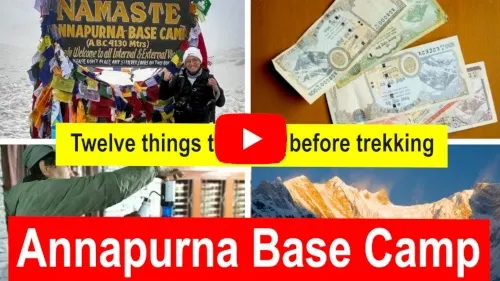

Kathleen
Saturday 20th of April 2024
How much MYR did you bring to change to Nepalese rupee for your entire trip, given all meals are covered for the trip for 13 days there?
kwankp
Monday 22nd of April 2024
All meals during trekking are included. However, we must pay for our food in Pokhara, Kathmandu, and Lumbini. Price at these places is about the same as the average cafe in Malaysia. We spend an average of RM100 daily, including buying supplies, extra food, taxi fare,etc.
Just uploaded another video about this. Please check it out https://youtu.be/cj3htwNsjx4